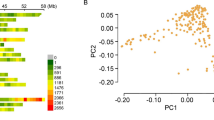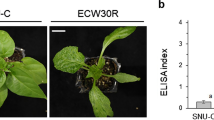Abstract
Cowpea [Vigna unguiculata (L.) Walp.] is an important legume crop, widely grown in Africa, South America, South Asia, Southeast Asia, and the southern United States. Cowpea is consumed as both fresh vegetable and dry grain, and as an animal feed and fodder, and it is a major dietary protein source that complements cereal-based diet. Cowpea mosaic virus (CPMV) causes a severe yield loss of cowpea in many areas worldwide notably in the Africa. Utilization of host genetic resistance is the most effective control method for the viral disease. The objective of this research is to conduct genome-wide association analysis and identify single nucleotide polymorphism (SNP) markers associated with CPMV resistance in cowpea. Three hundred and thirty-three cowpea germplasm accessions, originally collected from 39 different countries and 1033 SNPs identified from genotyping by sequencing approach were used in this study. Single marker regression, general linear model, and mixed linear model in Tassel 5 were used for association analysis of CPMV resistance. Six SNP markers (C35069548_1883, scaffold65342_6794, scaffold66293_6549, scaffold95805_2175, C35081948_540, and scaffold17319_4417) were strongly associated with the CPMV resistance, of which the first three were associated for immune and the remaining three were associated with hypersensitive response. SNP markers identified in this research will be a potential tool to use in cowpea molecular breeding to develop CPMV resistant cultivars through marker-assisted selection.



Similar content being viewed by others
References
Bradbury PJ, Zhang Z, Kroon DE, Casstevens TM, Ramdoss Y, Buckler ES (2007) TASSEL: software for association mapping of complex traits in diverse samples. Bioinformatics 23:2633–2635. doi:10.1093/bioinformatics/btm308
Cao K, Zhou Z, Wang Q, Guo J, Zhao P, Zhu G, Fang W, Chen C, Wang X, Wang X, Tian Z, Wang L (2016) Genome-wide association study of 12 agronomic traits in peach. Nat Commun 7:13246. doi:10.1038/ncomms13246
Chandrasekaran J, Brumin M, Wolf D, Leibman D, Klap C, Pearlsman M, Sherman A, Arazi T, Gal-On A (2016) Development of broad virus resistance in non-transgenic cucumber using CRISPR/Cas9 technology. Mol Plant Pathol 17:1140–1153
Earl DA, vonHoldt BM (2012) STRUCTURE HARVESTER: a website and program for visualizing STRUCTURE output and implementing the Evanno method. Conserv Genet Resour 4:359–361
Elshire RJ, Glaubitz JC, Sun Q, Poland JA, Kawamoto K, Buckler ES, Mitchell SE (2011) A robust, simple genotyping-by-sequencing (GBS) approach for high diversity species. PLoS ONE 6:e19379
Gillaspie AG, Hopkins MS, Pinnow DL, Hampton RO (1995) Seedborne viruses in preintroduction cowpea seed lots and establishment of virus-free accessions. Plant Dis 79:388–391
Gillaspie AG Jr, Mitchell SE, Stuart GW, Bozarth RF (1999) RT-PCR method for detecting cowpea mottle carmovirus in Vigna germ plasm. Plant Dis 83:639–643
Hulbert SH, Bennetzen JL (1991) Recombination at the Rp1 locus of maize. MGG Mol General Genet 226:377–382. doi:10.1007/BF00260649
Kiefer MC, Bruening G, Russell ML (1984) RNA and capsid accumulation in cowpea protoplasts that are resistant to cowpea mosaic virus strain SB. Virology 137:371–381
Kumar S, Stecher G, Tamura K (2016) MEGA7: molecular evolutionary genetics analysis version 7.0 for bigger datasets. Mol Biol Evol 33:1870–1874. doi:10.1093/molbev/msw054
Lipka AE, Kandianis CB, Hudson ME, Yu J, Drnevich J, Bradbury PJ, Gore MA (2015) From association to prediction: statistical methods for the dissection and selection of complex traits in plants. Curr Opin Plant Biol 24:110–118
Martins LMV, Xavier GR, Rangel FW, Ribeiro JRA, Neves MCP, Morgado LB, Rumjanek NG (2003) Contribution of biological nitrogen fixation to cowpea: a strategy for improving grain yield in the semi-arid region of Brazil. Biol Fertil Soils 38:333–339. doi:10.1007/s00374-003-0668-4
Muchero W, Diop NN, Bhat PR, Fenton RD, Wanamaker S, Pottorff M, Hearne S, Cisse N, Fatokun C, Ehlers JD, Roberts PA, Close TJ (2009) A consensus genetic map of cowpea [Vigna unguiculata (L) Walp.] and synteny based on EST-derived SNPs. Proc Natl Acad Sci USA 106:18159–18164. doi:10.1073/pnas.0905886106
Omueti O, Singh BB (1987) Nutritional attributes of improved varieties of cowpea (Vigna unguiculata (L.) Walp.). Hum Nutr Food Sci Nutr 41:103–112
Ouédraogo JT, Gowda BS, Jean M, Close TJ, Ehlers JD, Hall AE, Gillaspie AG, Roberts PA, Ismail AM, Bruening G, Gepts P, Timko MP, Belzile FJ (2002) An improved genetic linkage map for cowpea (Vigna unguiculata L.) combining AFLP, RFLP, RAPD, biochemical markers, and biological resistance traits. Genome 45:175–188. doi:10.1139/g01-102
Palanga E, Filloux D, Martin DP, Fernandez E, Gargani D, Ferdinand R, Zabré J, Bouda Z, Neya JB, Sawadogo M, Traore O, Peterschmitt M, Roumagnac P (2016) Metagenomic-based screening and molecular characterization of cowpea-infecting viruses in Burkina Faso. PLoS ONE. doi:10.1371/journal.pone.0165188
Ponz F, Russell ML, Rowhani A, Bruening G (1988) A cowpea line has distinct genes for resistance to tobacco ringspot virus and cowpea mosaic virus. Phytopathology 78:1124–1128
Pritchard JK, Stephens M, Donnelly P (2000) Inference of population structure using multilocus genotype data. Genetics 155:945–959. doi:10.1111/j.1471-8286.2007.01758.x
Qin J, Shi A, Xiong H, Mou B, Motes D, Lu W, Miller JC, Scheuring DC, Nzaramba MN, Weng Y, Yang W (2016) Population structure analysis and association mapping of seed antioxidant content in USDA cowpea (Vigna unguiculata L. Walp.) core collection using SNPs. Can J Plant Sci 96(6):1026–1036
Qin J, Shi A, Mou B, Bhattarai G, Yang W, Weng Y, Motes D (2017) Association mapping of aphid resistance in USDA cowpea (Vigna unguiculata L. Walp.) core collection using SNPs. Euphytica. doi:10.1007/s10681-016-1830-z
Rafalski A (2002) Applications of single nucleotide polymorphisms in crop genetics. Curr Opin Plant Biol 5:94–100
Shi A, Buckley B, Mou B, Motes D, Morris JB, Ma J, Xiong H, Qin J, Yang W, Chitwood J (2016) Association analysis of cowpea bacterial blight resistance in USDA cowpea germplasm. Euphytica 208:143–155
Sterk P, De Jager CP (1987) Interference between cowpea mosaic virus and cowpea severe mosaic virus in a cowpea host immune to cowpea mosaic virus. J General Virol 68:2751–2758
Tao Y, Jiang L, Liu Q, Zhang Y, Zhang R, Ingvardsen CR, Frei UK, Wang B, Lai J, Lübberstedt T, Xu M (2013) Combined linkage and association mapping reveals candidates for Scmv1, a major locus involved in resistance to sugarcane mosaic virus (SCMV) in maize. BMC Plant Biol 13:162. doi:10.1186/1471-2229-13-162
Wolfe MD, Rabbi IY, Egesi C, Hamblin M, Kawuki R, Kulakow P, Lozano R, Carpio DP Del, Ramu P, Jannink J-L (2016) Genome-wide association and prediction reveals genetic architecture of cassava mosaic disease resistance and prospects for rapid genetic improvement. Plant Genome 9(2). doi:10.3835/plantgenome2015.11.0118
Xiong H, Shi A, Mou B, Qin J, Motes D, Lu W, Ma J, Weng Y, Yang W, Wu D (2016) Genetic diversity and population structure of cowpea (Vigna unguiculata l. walp). PLoS ONE. doi:10.1371/journal.pone.0160941
Yang P, Lüpken T, Habekuss A, Hensel G, Steuernagel B, Kilian B, Ariyadasa R, Himmelbach A, Kumlehn J, Scholz U (2014a) PROTEIN DISULFIDE ISOMERASE LIKE 5-1 is a susceptibility factor to plant viruses. Proc Natl Acad Sci 111:2104–2109
Yang X, Caro M, Hutton SF, Scott JW, Guo Y, Wang X, Rashid MH, Szinay D, de Jong H, Visser RGF, Bai Y, Du Y (2014b) Fine mapping of the tomato yellow leaf curl virus resistance gene Ty-2 on chromosome 11 of tomato. Mol Breed 34:749–760. doi:10.1007/s11032-014-0072-9
Yu J, Pressoir G, Briggs WH, Vroh Bi I, Yamasaki M, Doebley JF, McMullen MD, Gaut BS, Nielsen DM, Holland JB, Kresovich S, Buckler ES (2006) A unified mixed-model method for association mapping that accounts for multiple levels of relatedness. Nat Genet 38:203–208. doi:10.1038/ng1702
Author information
Authors and Affiliations
Corresponding author
Electronic supplementary material
Below is the link to the electronic supplementary material.
10681_2017_2015_MOESM1_ESM.xlsx
Table S1 Cowpea accession, plant name, CPMV rating, origin region (country) and the accessions assigned to clusters based on STRUCTURE 2.3.4 analysis, and a ID composed of accession name, country of origin and STRUCTURE generated cluster group merged into a single taxon name for MEGA analysis in this study. Table S2 SNP marker associated with the cowpea mosaic virus (CPMV) resistance response in cowpea. A panel of 333 accessions were used for the association analysis using two and three population structure components. Association analysis was further conducted on a subset of accessions that were scored as immune and hypersensitive to uncover genetic loci associated with each phenotypic class. Table S3 Selection accuracy calculated for a panel of 333 cowpea accessions. Number of accessions on each genotypic class were counted for all 333 accessions, 231 susceptible accessions and 102 resistant accessions. The 102 resistant accessions consist 47, 48, and 7 genotypes scored as immune, hypersensitive and resistant respectively. Table S4 Selection accuracy calculated for a panel of 278 cowpea accessions scored as immune and susceptible. Number of accessions on each genotypic class were counted for all 278 accessions, 231 susceptible accessions and 47 resistant accessions that were scored as 'immune'. Table S5 Selection accuracy calculated for a panel of 279 cowpea accessions scored as hypersensitive and susceptible. Number of accessions on each genotypic class were counted for all 279 accessions, 231 susceptible accessions and 48 resistant accessions that were scored as 'hypersensitive'. Figure S1 Distribution of Cowpea accessions analyzed in this study per country of origin. Number of accessions are labeled on outside end of the bars for each country. Figure S2-1 The rectangular phylogenetic tree combining populations clusters (Q1 to Q2) from STRUCTURE 2.3.4 and drawn using the Maximum Likelihood (ML) method in MEGA 7. The cowpea accession number, the accession original country, and the STRUCTURE generated population cluster (Q matrix) were merged together into one taxon name and trees were drawn by MEGA. The colored shape and branch matches the structure population (red for Q1, green for Q2, and the empty purple square for the admixture Q1Q2). Figure S2-2 The circular phylogenetic tree combining populations clusters (Q1 to Q2) from STRUCTURE 2.3.4 and drawn using the Maximum Likelihood (ML) method in MEGA 7. The cowpea accession number, the accession original country, and the STRUCTURE generated population cluster (Q matrix) were merged together into one taxon name and trees were drawn by MEGA. The colored shape and branch matches the structure population (red for Q1, green for Q2, and the empty purple square for the admixture Q1Q2). Figure S3-1 The rectangular phylogenetic tree combining populations clusters (Q1, Q2, Q3) from STRUCTURE 2.3.4 and drawn using the Maximum Likelihood (ML) method in MEGA 7. The cowpea accession number, the accession original country, and the STRUCTURE generated population cluster (Q matrix) were merged together into one taxon name and trees were drawn by MEGA. The colored shape and branch matches the structure population (red for Q1, green for Q2, blue for Q3 and the pink empty square for the admixtures). Figure S3-2 The circular phylogenetic tree combining populations clusters (Q1, Q2, Q3) from STRUCTURE 2.3.4 and drawn using the Maximum Likelihood (ML) method in MEGA 7. The cowpea accession number, the accession original country, and the STRUCTURE generated population cluster (Q matrix) were merged together into one taxon name and trees were drawn by MEGA. The colored shape and branch matches the structure population (red for Q1, green for Q2, blue for Q3 and the pink empty square for the admixtures). (XLSX 1640 kb)
Rights and permissions
About this article
Cite this article
Bhattarai, G., Shi, A., Qin, J. et al. Association analysis of cowpea mosaic virus (CPMV) resistance in the USDA cowpea germplasm collection. Euphytica 213, 230 (2017). https://doi.org/10.1007/s10681-017-2015-0
Received:
Accepted:
Published:
DOI: https://doi.org/10.1007/s10681-017-2015-0




